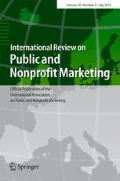Abstract
The present study aims at establishing a relationship between communication strategies and consumer behavior in social and nonprofit specific contexts of marketing (e.g. Public Security Police (PSP) in Portugal). The actions of raising awareness among the schools about the themes of “animal mistreatment” and "preventing dating violence" among the young are examples of interpersonal communication established with the population and materializing along with social networking policing. Based on a qualitative approach, it also aims at analyzing the good digital marketing and communication practices in social networks. Two in-depth interviews (police subcommittee and marketing coordinator) and a focus group (11 residents / participants) were conducted. The results show that the digital communication strategy can be advantageous to bring police forces closer to the local community and, therefore, promote a sense of belonging and commitment for the benefit of global well-being.




Similar content being viewed by others
References
Alves, H. (2010). The who, where, and when of social marketing. Journal of Nonprofit & Public Sector Marketing, 22(4), 288–311.
Alves, H., Fernandes, C., & Raposo, M. (2016). Social media marketing: a literature review and implications. Psychology & Marketing, 33(12), 1029–1038.
Baptista, N., Alves, H., & Pinho, J. C. (2020). Uncovering the use of the social support concept in social marketing interventions for health. Journal of Nonprofit & Public Sector Marketing, 1–35.
Bergen, N., & Labonté, R. (2020). “Everything is perfect, and we have no problems”: Detecting and limiting social desirability bias in qualitative research. Qualitative Health Research, 30(5), 783–792.
Blery, E. K., Katseli, E., & Tsara, N. (2010). Marketing for a non-profit organization. International Review on Public and Nonprofit Marketing, 7(1), 57–68.
Denhardt, R. B., & Denhardt, J. V. (2000). The new public service: Serving rather than steering. Public Administration Review, 60(6), 549–559.
Denzin, N. K., & Lincoln, Y. S. (2000). Strategies of inquiry. Handbook of Qualitative Research, 2, 367–378.
Dolnicar, S., & Lazarevski, K. (2009). Marketing in non-profit organizations: An international perspective. International Marketing Review, 26(3), 275–291.
Elliott, M. R. (2003). Causality and how to model it. BT Technology Journal, 21(2), 120–125.
Fernandes, P. O., & Correia, L. F. (2013). Consumer attitudes toward the marketing practices in Portugal. Tourism & Management Studies, 9(2), 86–92.
Gountas, J., Gountas, S., Ciorciari, J., & Sharma, P. (2019). Looking beyond traditional measures of advertising impact: Using neuroscientific methods to evaluate social marketing messages. Journal of Business Research, 105, 121–135.
Kotler, P., & Lee, N. (2008). Social marketing: Influencing behaviors for good. Sage.
Kotler, P., & Zaltman, G. (1971). Social Marketing: An approach to planned social change. Journal of Marketing, 35, 3–12.
Kotler, P., Roberto, N., Lee, N., & Marketing, S. (2002). Improving the quality of life. Social marketing. (2nd ed.). Sage Publications.
MacFadyen, L., Amos, A., Hastings, G., & Parkes, E. (2003). ‘They look like my kind of people’—perceptions of smoking images in youth magazines. Social Science & Medicine, 56(3), 491–499.
Mawby, R. C., & Worthington, S. (2002). Marketing the Police–from a force to a service. Journal of Marketing Management, 18(9–10), 857–876.
Rundle-Thiele, S., David, P., Willmott, T., Pang, B., Eagle, L., & Hay, R. (2019). Social marketing theory development goals: An agenda to drive change. Journal of Marketing Management, 35(1–2), 160–181.
Saunders, M., Lewis, P., & Thornhill, A. (2009). Research methods for business students. Pearson education.
Sawyer, S. M., Afifi, R. A., Bearinger, L. H., Blakemore, S. J., Dick, B., Ezeh, A. C., & Patton, G. C. (2012). Adolescence: A foundation for future health. The Lancet, 379(9826), 1630–1640.
Sousa, B., & Soares, D. (2019). Combat to abandonment and mistreatment of Animals: A case study applied to the public security police (Portugal). In M. Mercedes Galan-Ladero & Helena M. Alves (Eds.), Case Studies on Social Marketing. A Global Perspective (pp. 245–252). Springer. https://doi.org/10.1007/978-3-030-04843-3.
Wymer, W., & Sargeant, A. (2006). Insights from a review of the literature on cause marketing. International Review on Public and Non Profit Marketing, 3(1), 9–15.
Yorke, D. A. (1984). Marketing and non-profit-making organisations. European Journal of Marketing, 18(2), 17–22.
Author information
Authors and Affiliations
Corresponding author
Additional information
Publisher's note
Springer Nature remains neutral with regard to jurisdictional claims in published maps and institutional affiliations.
Rights and permissions
About this article
Cite this article
Soares, D.B., Sousa, B.B. The role of communication in consumer behavior in social and nonprofit marketing: the case of psp in Portugal. Int Rev Public Nonprofit Mark 19, 1–13 (2022). https://doi.org/10.1007/s12208-021-00294-3
Received:
Accepted:
Published:
Issue Date:
DOI: https://doi.org/10.1007/s12208-021-00294-3




